
Passion Fruit Yellow vs Purple: Taste, Nutrition, and Growth
Share
The vibrant world of passion fruit presents two distinct varieties that tantalize taste buds and enrich diets: the yellow and the purple. Each type features unique characteristics, from flavor profiles to nutritional benefits, making them suitable for various culinary uses and gardening conditions.
As enthusiasts delve into the differences between yellow and purple passion fruit, a critical question emerges: which variety truly excels in taste, nutrition, and ease of growth? This exploration aims to unveil the secrets behind these tropical treasures, guiding readers toward informed choices for their palates and gardens alike.
🌱 Ready to grow a passion fruit tree?
Start with exploring the Passion Fruit Trees collection at Everglades Farm.
This article compares yellow and purple passion fruit, emphasizing their differences in taste, nutrition, growth conditions, and culinary uses.
- Yellow passion fruit is characterized by its larger size and tangy flavor, making it primarily suitable for juice production.
- In contrast, purple passion fruit is smaller and sweeter, often preferred for fresh consumption.
- Both varieties provide unique nutritional benefits and necessitate specific growth conditions for optimal cultivation, making them valuable additions to any garden.
Overview of Yellow and Purple Passion Fruit
In the discussion of passion fruit yellow vs purple, Yellow Passiflora edulis f. flavicarpa is characterized by its larger size, vibrant yellow exterior, and tangy taste, making it a popular choice for juice production due to its high juice yield. This variety thrives in tropical regions and is known for its vigorous growth, often producing more than 20 fruits per vine.
In contrast, when comparing passion fruit yellow vs purple, the violet edible plant (Passiflora edulis f. edulis) is smaller, features a dark violet exterior, and has a sweeter, more fragrant pulp. It typically matures between 60 to 90 days after flowering and is preferred for fresh consumption because of its rich flavor profile.
Both varieties are nutrient-dense, offering an array of vitamins and antioxidants, which enhance their appeal in home gardening. However, when discussing passion fruit yellow vs purple, the yellow variety is primarily utilized for juice, while the violet type is commonly enjoyed fresh or in desserts.
When examining the market share for tropical produce, particularly in the context of passion fruit yellow vs purple, it is considerable, with over 95% of global output directed towards juice extraction, while the purple variety is more often sold as fresh produce. This distinction underscores the importance of selecting the appropriate type based on intended use, thereby ensuring successful home gardening experiences.
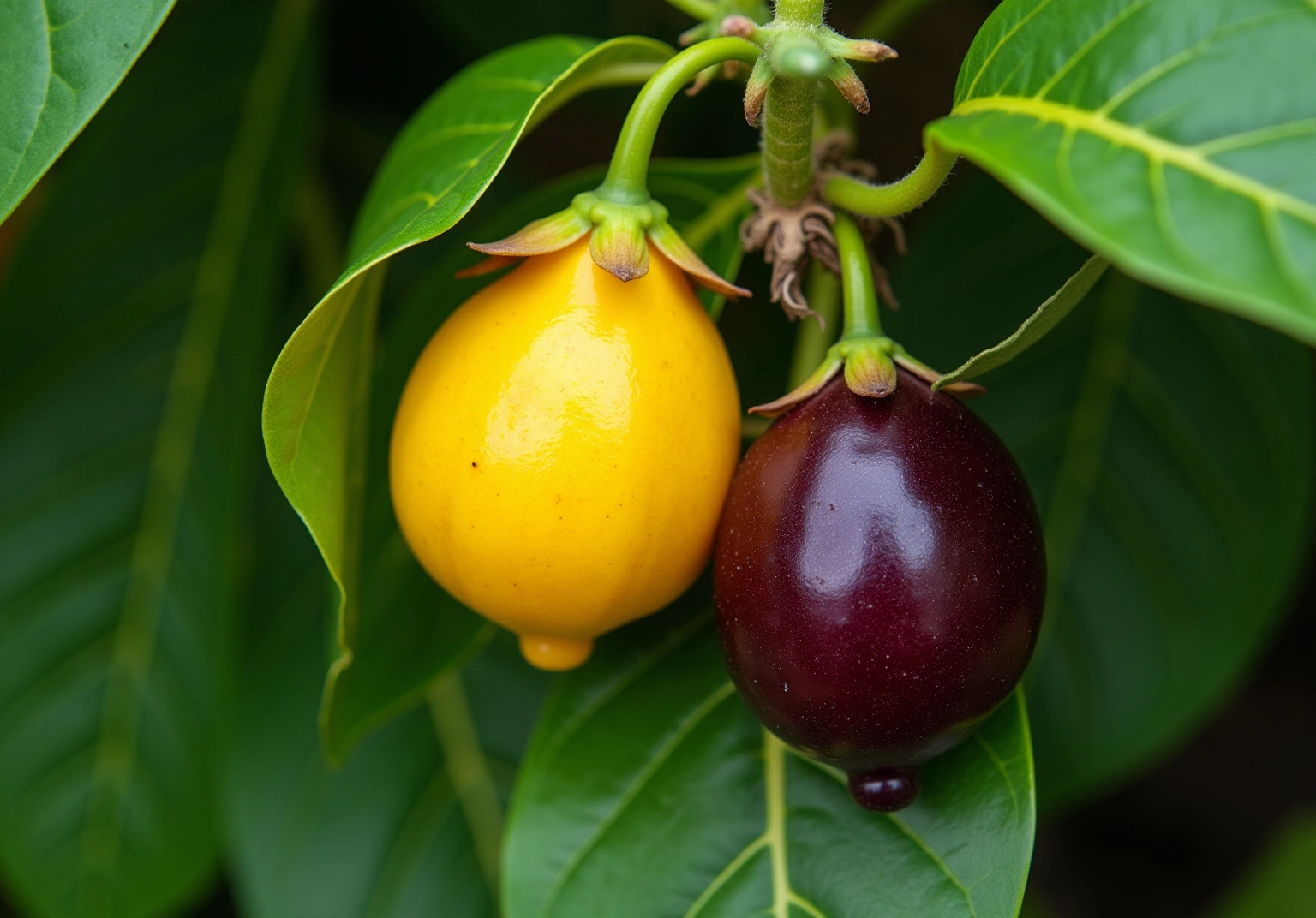
Taste Comparison: Yellow vs. Purple Passion Fruit
When comparing passion fruit yellow vs purple, the yellow passionfruit is known for its sharp, tangy taste, often described as a tropical explosion, making it an excellent choice for juices and desserts.
In contrast, when comparing passion fruit yellow vs purple, the violet variety offers a sweeter, more floral flavor with lower acidity, making it ideal for fresh consumption and gourmet dishes.
Taste tests reveal that while some individuals appreciate the strong tartness of passion fruit yellow vs purple varieties, others favor the fragrant sweetness of the violet type, highlighting the subjective nature of flavor preferences.
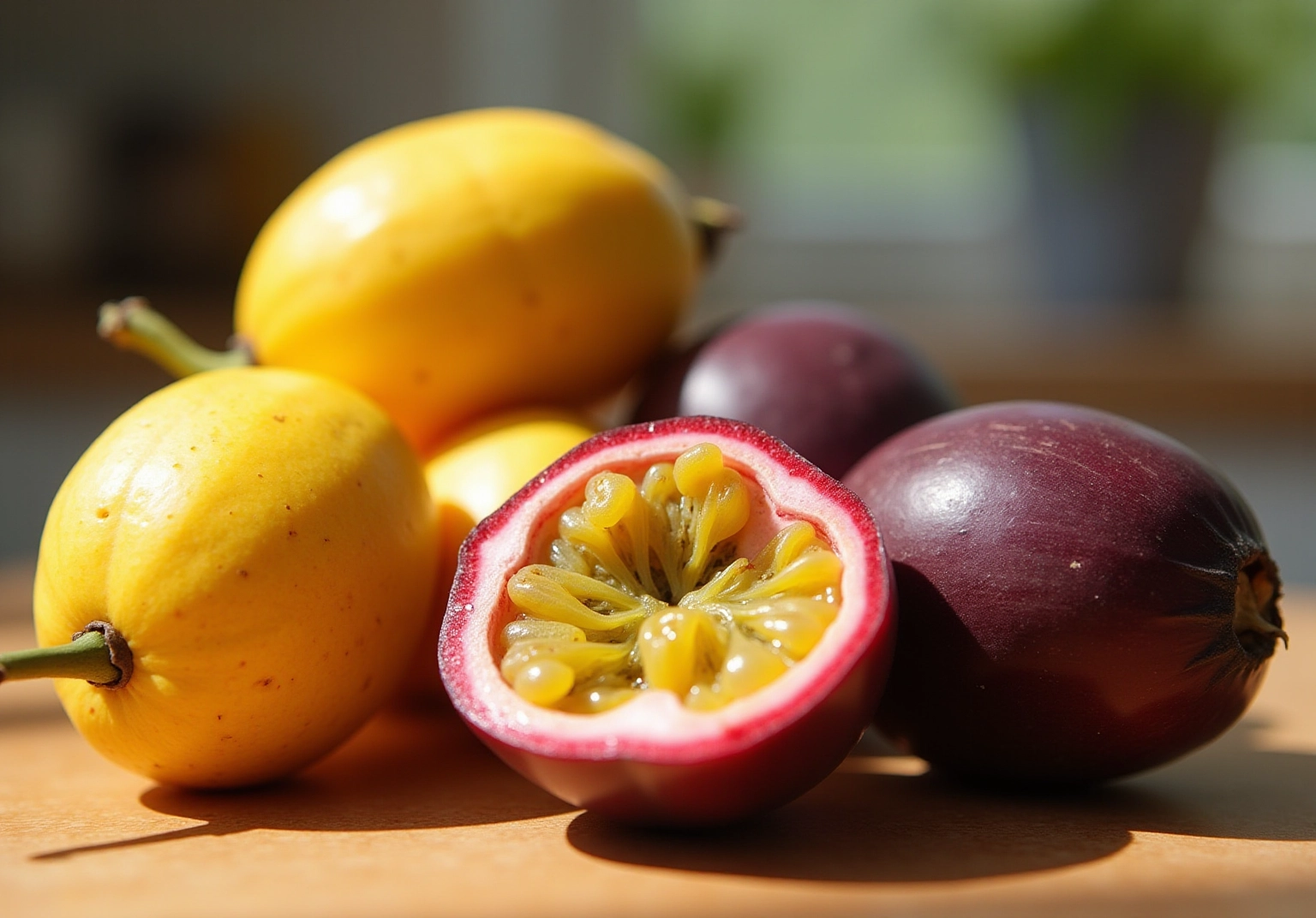
Nutritional Analysis: Benefits of Each Variety
When comparing passion fruit yellow vs purple, it's clear that yellow passionflower is a powerhouse of vitamin C, dietary fiber, and antioxidants, which play a crucial role in supporting immune function and promoting digestive health. Its higher citric acid content contributes to a distinctly tart flavor, making it a refreshing choice. In contrast, when comparing passion fruit yellow vs purple, the purple passion fruit is equally rich in vitamin C but stands out with a greater concentration of anthocyanins, compounds known for their heart health benefits and anti-inflammatory properties. Both passion fruit yellow vs purple types not only enrich a balanced diet but also provide unique health benefits, such as improved digestion and enhanced cardiovascular health.
To successfully grow these varieties in your backyard, consider selecting the best-suited type for your climate and soil conditions. Frequent intake of these fruits can greatly enhance overall health, with research showing that a cup of this tropical item can offer between 21% and 48% of the suggested daily requirement for iron, further reinforcing its nutritional benefits. By adhering to crucial planting and maintenance advice, you can savor the health advantages of these tasty crops directly from your garden.
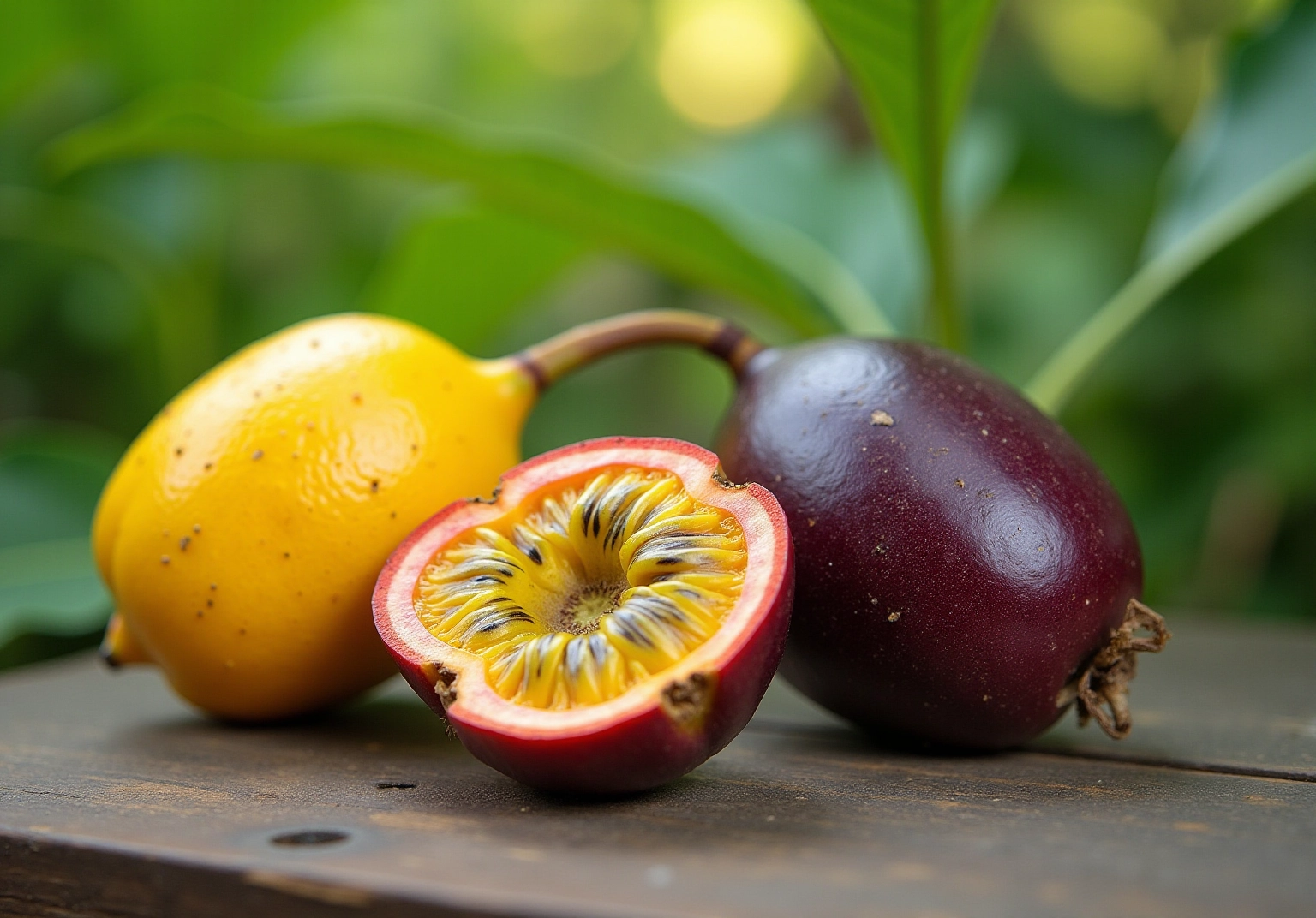
Growth Conditions: Cultivation Requirements for Yellow and Purple Varieties
When comparing passion fruit yellow vs purple, the yellow tropical variety thrives in warm, tropical climates, requiring full sun exposure and well-drained, fertile soil. It flourishes in USDA zones 9-11, where temperatures ideally range from 70°F to 90°F (21°C to 32°C). However, this type is less frost-tolerant; temperatures below 30°F (-1°C) can stunt growth or even lead to plant death.
In contrast, the adaptability of the purple passion fruit is greater, as it can tolerate slightly cooler temperatures and partial shade, making it suitable for a wider range of garden settings. Both varieties benefit from regular watering and organic fertilization, which are crucial for encouraging healthy growth and maximizing yield.
Case studies indicate that yellow tropical berries can be successfully cultivated in states like:
- California
- Florida
- Texas
- Arizona
- Louisiana
Meanwhile, the purple passionflower is best cultivated at greater elevations, usually between 1200-2000 meters, and requires comparable attention to guarantee strong yields. Understanding these specific cultivation needs is crucial for gardeners aiming to cultivate either variety successfully.
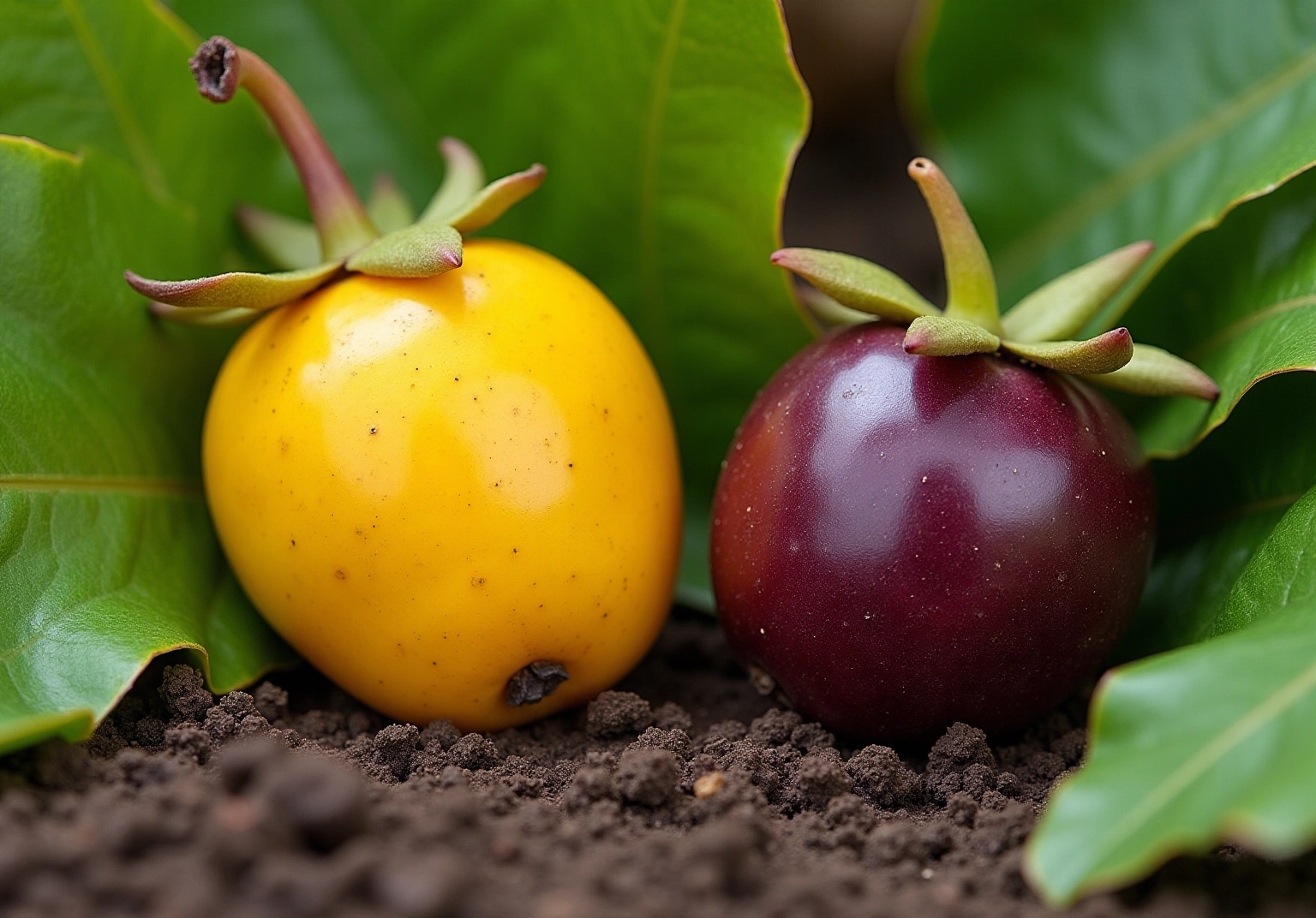
Pest and Disease Resistance: Comparing Vulnerabilities
Yellow tropical produce is notably more susceptible to root knot nematodes and specific fungal diseases, which can significantly affect its yield. In contrast, purple tropical produce demonstrates superior resistance to these pests and diseases, making it a more resilient option for gardeners. Specific heritability estimates for plant characters in the Natural Agriculture system range from 25.52% to 81.13%, indicating variability in resilience among different genotypes. Despite these differences, both varieties necessitate diligent care and monitoring to avert infestations and promote healthy growth.
Common ailments impacting the production of passion fruit yellow vs purple include woodiness disease and bacterial spot, which can greatly restrict production. Utilizing integrated pest management techniques, such as choosing virus-free seedlings and prompt elimination of infected plants, can enhance the resilience of varieties when comparing passion fruit yellow vs purple. Agricultural experts stress the significance of these methods, highlighting that effective management can reduce the risks presented by common diseases and improve overall production.
Culinary Uses: How Each Variety is Best Utilized
Yellow passionfruit is celebrated for its tangy taste, making it a popular choice in beverages, desserts, and sauces. Its vibrant flavor is particularly appreciated in tropical cocktails and refreshing sorbets, where it imparts a zesty kick. In contrast, violet exotic produce offers a sweeter profile, rendering it ideal for fresh consumption, mixed salads, and gourmet dishes that showcase its aromatic qualities.
Although both varieties, passion fruit yellow vs purple, can be used interchangeably in recipes, recognizing their distinct flavor profiles allows for a more tailored culinary experience. For instance, in the debate of passion fruit yellow vs purple, the purple variety is often recommended for desserts requiring a sweeter touch, while the yellow type excels in recipes that benefit from its tartness. This versatility not only enhances the overall dish but also caters to diverse taste preferences, making both varieties essential in any kitchen.
Furthermore, over 95% of the yellow variety's production is primarily utilized for juice extraction, underscoring its significance in culinary applications. Nutritionally, this tropical delight is rich in vitamin C and dietary fiber, offering health benefits alongside its delightful taste. However, it is crucial to note that the tropical berry contains cyanogenic glycosides, which can be harmful in high amounts, especially in unripe specimens. Therefore, understanding both the culinary uses and safety considerations of passion fruit is essential for home gardeners.
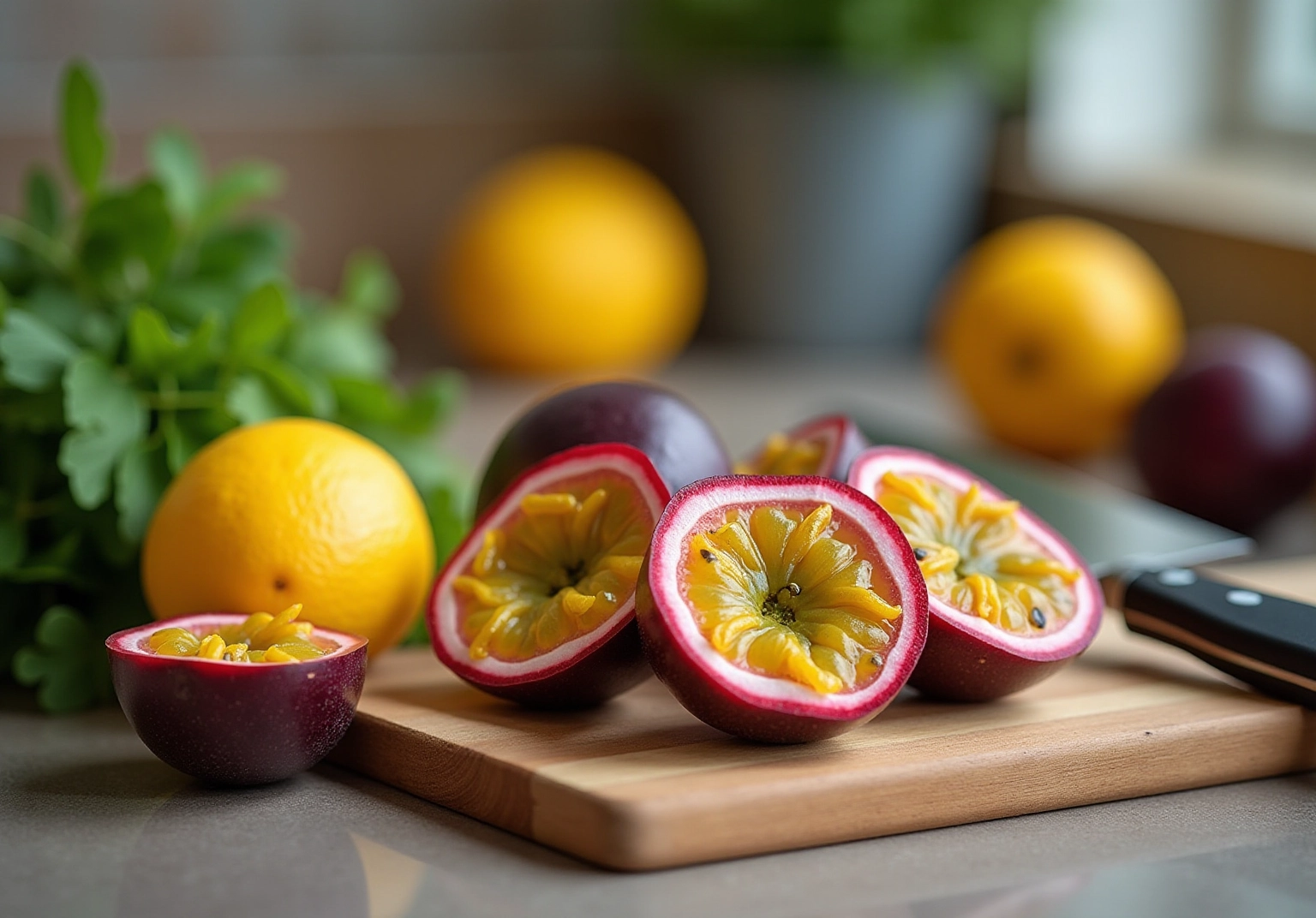
Conclusion
The comparison of yellow and purple passion fruit reveals distinct characteristics that cater to various culinary and gardening needs. The yellow variety is recognized for its larger size and tangy flavor, making it ideal for juice production. In contrast, the purple variant stands out with its sweeter taste and aromatic qualities, perfect for fresh consumption. Understanding these differences is essential for anyone looking to enjoy the unique flavors and benefits each type has to offer.
Throughout this discussion, key points such as nutritional benefits, growth conditions, and culinary uses of both varieties have been thoroughly examined. The yellow passion fruit is rich in vitamin C and dietary fiber, while the purple variety boasts higher levels of anthocyanins, which promote heart health. Additionally, the growth requirements highlight the yellow fruit's preference for warmer climates, whereas the purple type demonstrates greater adaptability to varying conditions.
Ultimately, choosing between yellow and purple passion fruit depends on personal taste preferences and intended culinary applications. Whether one seeks to create refreshing juices or indulge in sweet desserts, both varieties provide a wealth of flavors and health benefits. Embracing the unique qualities of each type can enhance not only garden productivity but also culinary creativity, encouraging a deeper appreciation for these tropical treasures.
Let’s Grow Passion Fruit Together
👉 Shop Purple Passion
👉 Shop Yellow Passion Fruit
🌱 About Everglades Farm
Frequently Asked Questions
What are the main characteristics of yellow passion fruit?
Yellow passion fruit (Passiflora edulis f. flavicarpa) is larger, has a vibrant yellow exterior, and a tangy taste, making it popular for juice production due to its high juice yield. It thrives in tropical regions and can produce more than 20 fruits per vine.
How does purple passion fruit differ from yellow passion fruit?
Purple passion fruit (Passiflora edulis f. edulis) is smaller, features a dark violet exterior, and has a sweeter, more fragrant pulp. It matures between 60 to 90 days after flowering and is preferred for fresh consumption due to its rich flavor profile.
What are the nutritional benefits of both yellow and purple passion fruit?
Both yellow and purple passion fruits are nutrient-dense, offering a variety of vitamins and antioxidants, making them appealing for home gardening.
How is yellow passion fruit typically used compared to purple passion fruit?
The yellow variety is primarily utilized for juice production, while the purple variety is commonly enjoyed fresh or in desserts.
What is the market share for yellow and purple passion fruit?
Over 95% of global output of passion fruit is directed towards juice extraction from the yellow variety, while the purple variety is more often sold as fresh produce.
How do the tastes of yellow and purple passion fruit compare?
Yellow passion fruit has a sharp, tangy taste, often described as a tropical explosion, making it suitable for juices and desserts. In contrast, purple passion fruit offers a sweeter, more floral flavor with lower acidity, ideal for fresh consumption and gourmet dishes.
Are there subjective preferences in taste between the two varieties?
Yes, taste tests reveal that some individuals prefer the strong tartness of yellow passion fruit, while others favor the fragrant sweetness of the purple type, highlighting the subjective nature of flavor preferences.


